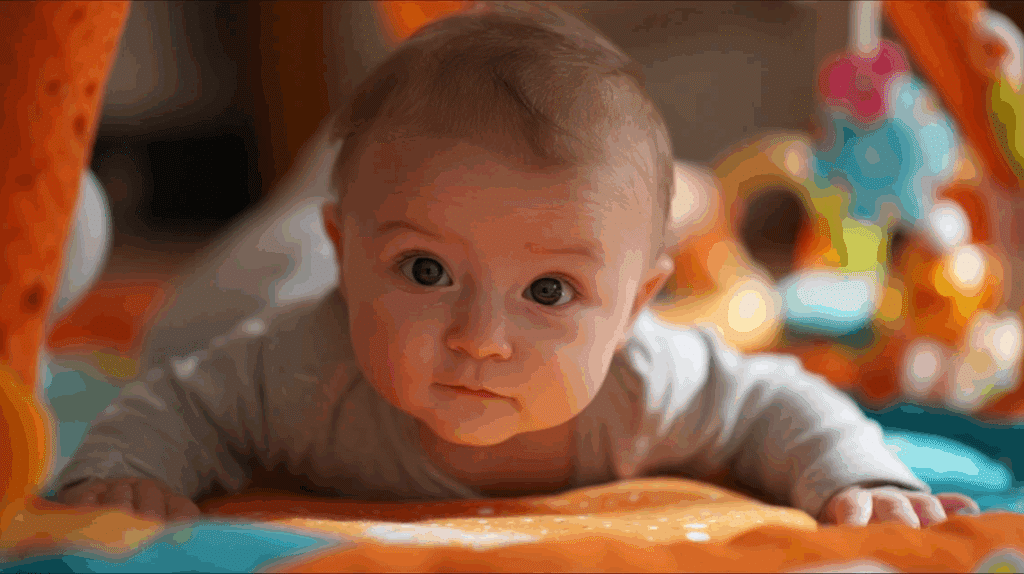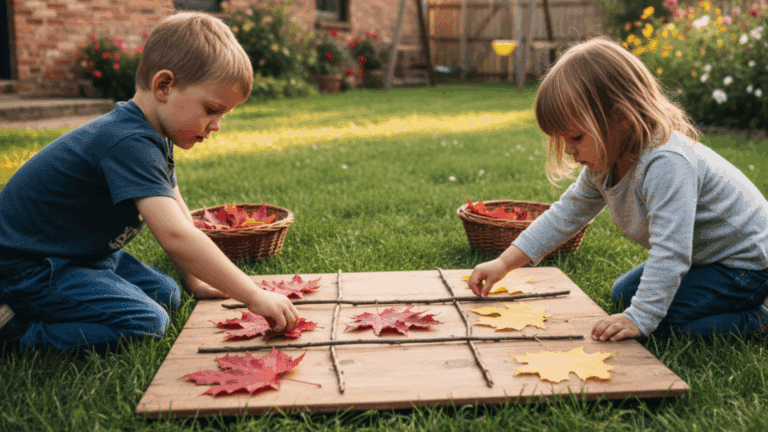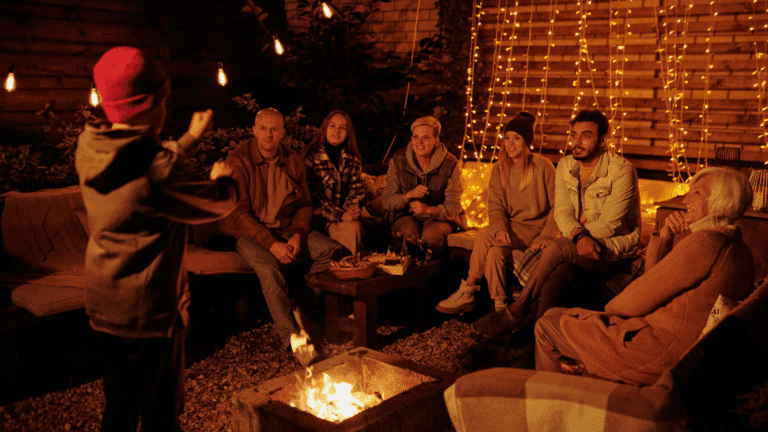There’s nothing quite like watching a baby find out they can move around on their own. It’s like witnessing a tiny human unlock their first superpower!
One day, they’re content to stay wherever you put them, and the next day, they’re army-crawling toward that interesting dust bunny under the couch with the determination of a tiny wanderer.
The crawling milestone changes everything. Suddenly, baby-proofing becomes a serious business, and parents realize their little angel has transformed into a pint-sized escape artist.
But every baby does it differently and on their timeline. Some skip crawling entirely, while others perfect the art of bottom-scooting. Ready to plunge into this adorable chaos?
When Should You Expect My Baby to Crawl?
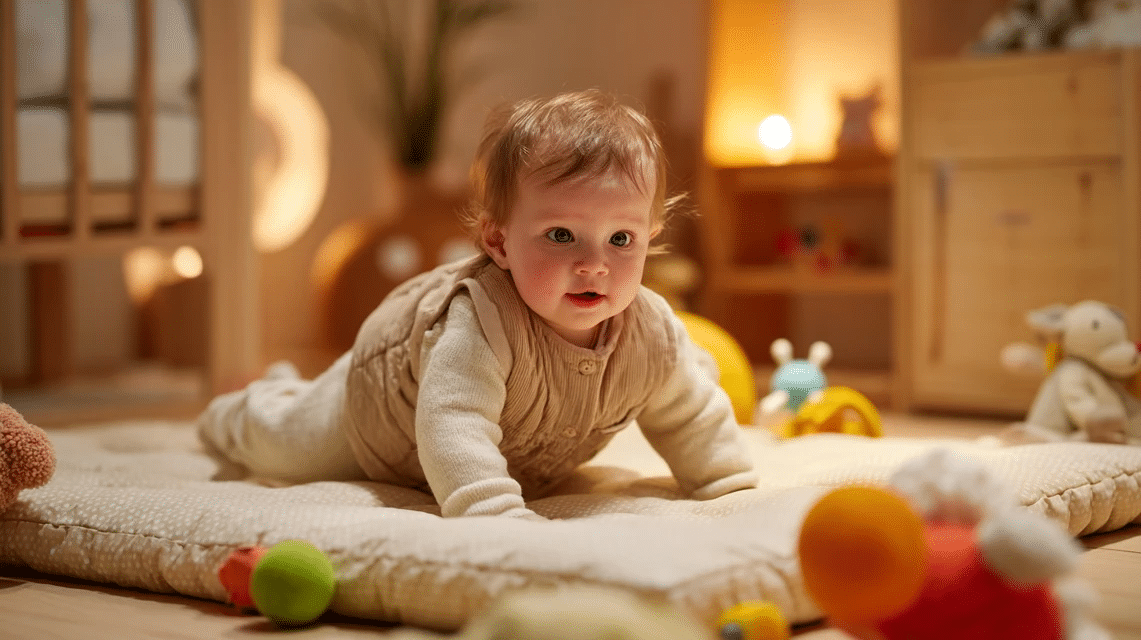
Somewhere between 6 and 10 months, but babies didn’t get the memo about following schedules! The timeline varies significantly, so pediatricians have learned to provide relatively wide ranges for this milestone.
The Early Birds (6-7 months)
Some babies are just born ready to take over the world, and they start making moves earlier than expected.
These little explorers often have strong upper body strength from lots of tummy time and seem determined to reach every interesting object just out of their grasp.
The Sweet Spot (7-9 months)
This is when most babies decide that staying in one place is overrated and start experimenting with different ways to get around. They’ve usually mastered sitting up by now, which gives them a better view of all the things they want to investigate.
The combination of curiosity and developing muscle strength creates the perfect storm for crawling adventures.
The Fashionably Late Arrivals (9-10+ months)
Some babies take their sweet time with crawling, and that’s perfectly normal, too!
These little ones might be perfecting other skills, such as pulling themselves up to standing or working on their fine motor abilities. They’re prioritizing different developmental goals and will reach crawling when they’re ready.
Understanding the Crawling Stages of Your Baby
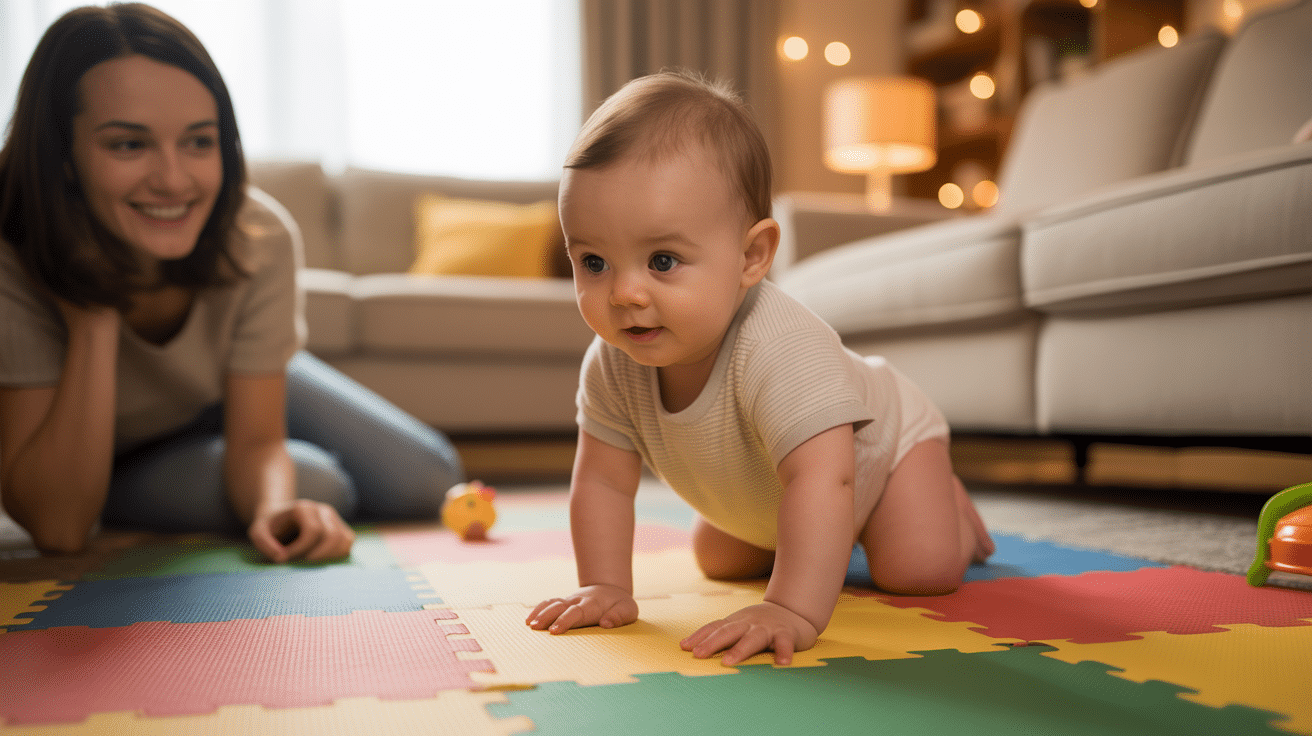
Understanding these stages helps parents know what to expect and how to encourage their little seekers safely.
Stage 1: The Belly Scoot (4-6 months)
This is where the quest begins. Its the most crucial crawling milestone, and it’s equal parts adorable and surprising!
Babies figure out that they can move their bodies around during tummy time, though they might end up going backward or spinning in circles instead of forward.
- What to expect: Baby starts pushing up during tummy time and might accidentally scoot backward or pivot in circles.
- Cautions: Make sure the floor is clean and soft, as they’ll be spending more time down there.
- Activities that help: Plenty of supervised tummy time, placing interesting toys just out of reach to motivate movement
Stage 2: The Rock and Roll (5-7 months)
Get ready for the cutest pre-crawling warm-up routine you’ve ever seen!
In this crawling milestone, the baby figures out how to get up on hands and knees but hasn’t quite mastered the coordination to move forward yet, so they rock back and forth with serious determination.
- What to expect: Baby gets up on hands and knees and rocks back and forth like they’re revving an engine.
- Cautions: They might rock so enthusiastically that they topple over, so clear the area of hard edges
- Activities that help: Encourage rocking by getting down and demonstrating and placing pillows around for safe landing spots
Stage 3: The Army Crawl (6-8 months)
This is when the baby becomes a tiny commando, pulling themselves across the floor with impressive arm strength! It might not look like traditional crawling, but it’s incredibly effective for reaching all those fascinating objects across the room.
- What to expect: Baby pulls themselves forward using their arms while their belly stays on the ground.
- Cautions: Check for small objects on the floor constantly; everything becomes a potential snack at this stage
- Activities that help: Create obstacle courses with pillows and demonstrate army crawling yourself (yes, you’ll look silly, but it works!).
Stage 4: The Classic Crawl (7-10 months)
Finally, the moment parents have been waiting for: real textbook crawling that looks like what you see in baby books!
Baby coordinates their arms and legs to move forward on hands and knees, and suddenly, the whole house becomes their playground.
- What to expect: Baby achieves the traditional hands-and-knee crawling motion and gains speed quickly.
- Cautions: It is time to seriously baby-proof; they can now reach higher surfaces and move faster than you expect.
- Activities that help: Set up safe exploration areas and crawl alongside them to demonstrate different movements and directions.
Stage 5: The Speed Demon (8-12 months)
Hold onto your hats because the baby has officially mastered crawling, and in this final crawling milestone, they are now ready to take on the world! They’re fast, fearless, and determined to inspect every corner, crevice, and climbing opportunity they can find.
- What to expect: Baby becomes a crawling expert and starts experimenting with crawling up stairs and over obstacles.
- Cautions: Install baby gates immediately, secure furniture to walls, and never leave them unattended on raised surfaces.
- Activities that help: Create safe climbing opportunities with cushions and practice going downstairs backward (the safest method).
Is the Baby Crawling Normally?

The world of baby development is wonderfully diverse, and a “normal” crawling milestone covers a surprisingly wide range of adorable and effective techniques.
Some babies are textbook crawlers, while others invent creative methods that work perfectly well for getting from point A to point B.
- Traditional hands-and-knees crawling is just one option: many babies prefer scooting, rolling, or bear-walking
- Backward crawling often precedes forward movement: it’s easier to push than pull, so don’t worry if your baby goes in reverse first.
- Some babies skip crawling entirely and go straight to walking: this happens in about 20% of babies and is entirely normal.
- Crawling speed varies dramatically: some babies are cautious, while others become instant speed demons.
- Different surfaces may require other techniques: babies often modify their crawling style when transitioning from carpet to hardwood floors.
- One-sided or asymmetrical crawling can be regular, but mention it to your pediatrician if it persists or seems extreme.
- Stop-and-start crawling is typical: babies often crawl a few steps, sit down to rest or play, and then continue.
How To Encourage Crawling in Babies
Sometimes, babies need a little motivation to get moving, and there are plenty of fun ways to encourage those first crawling attempts!
The key is that moving feels like play rather than pressure because babies are much more likely to try new things when they’re having fun and feeling confident.
Create Irresistible Motivation
Place favorite toys, colorful objects, or even yourself just out of the baby’s reach during floor time. The goal isn’t to frustrate them but to give them a reason to want to move forward.
Try using toys that light up, make sounds, or have interesting textures; anything that attracts the baby’s attention and makes them think, “I absolutely must have that right now!”
Make Tummy Time Enjoyable
Use colorful play mats, prop up books or picture cards for them to look at, or place a mirror in front of them so they can admire their adorable face.
The stronger their neck, arm, and core muscles get during tummy time, the easier crawling becomes.
Lead by Example and Make It Social
Get down on the floor and show the baby how it’s done! Crawl around yourself, make it look fun and exciting, and let them see that moving around opens up a whole world of possibilities.
You can also arrange playdates with other crawling babies; nothing motivates a baby quite like seeing another baby having a blast zooming around the room.
Conclusion
The crawling milestone is one of those beautiful reminders that babies develop at their own pace and in their own unique way.
The most important thing isn’t when your baby crawls or exactly how they do it.
Some babies will surprise you by skipping crawling altogether, while others will perfect seventeen different crawling techniques before moving on to walking.
These crawling days pass quickly, and soon, you’ll be missing the time when your biggest worry was if they could reach the coffee table.


